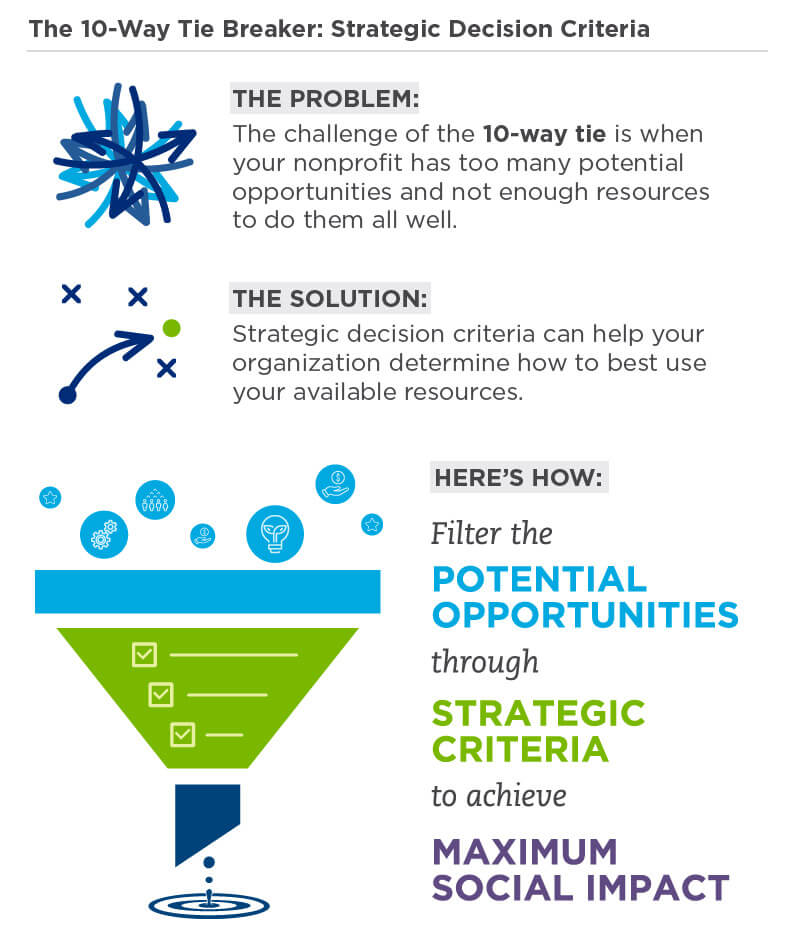Almost every nonprofit faces the conundrum of what to do when competing priorities are practically limitless, but resources are not. How to best use an organization’s finite resources to achieve optimal results is always top of mind for effective leaders.
In practice, this dilemma plays out for many nonprofits in a scenario we’ve heard some refer to as “the 10-way tie.” That’s when there are many things that your organization could do and would like to do, but you don’t have the resources to effectively tackle all of them at once. The good news: you don’t have to.
Some potential activities and opportunities will obviously help your nonprofit advance its mission more than others. How do you ensure your team agrees on what those things are and makes those decisions consistently? By properly applying strategic decision criteria, nonprofits can discover which actions have the potential to deliver the most impact on their highest-priority objectives, and then focus available resources in those areas.

Five Ways Strategic Criteria Can Help with Decision Making
Strategic decision-making criteria can help organizations structure and systematize their decision process in several important ways:
Align the team. Spelling out decision criteria takes the implicit factors that leaders use to make decisions and makes them explicit. In this way, decision criteria can ensure that options are evaluated according to a relatively uniform set of objective and measurable standards.
Increase transparency. Organizations with thoughtful, objective decision-making criteria can increase transparency by proactively sharing these criteria with internal and external stakeholders. That way, when the organization makes major decisions, everyone understands why it made such choices and how it arrives at those decisions.
Amplify equity. By ensuring equity priorities are part of the criteria—for example, by prioritizing specific populations or setting explicit diversity, equity, and inclusion goals.
Protect against oversights. Sometimes, when organizations are excited about a new idea or novel program, it can be easy to skip an important element of due diligence or overlook a potential pitfall. Explicit decision criteria help safeguard against these oversights by acting as a checklist to review when making important decisions.
Allow fair comparisons between seemingly disparate choices. Let’s say your organization has the opportunity to invest in two different programs, but only has the resources to pursue one. Decision-making criteria offer an objective framework for comparing apples with oranges in a rigorous way to ensure you pick the option with the best likelihood of delivering desired results.
How to Choose the Right Decision-Making Criteria for Your Organization
There is no one-size-fits-all set of universal decision-making criteria. Ultimately, such criteria work best when they are firmly rooted in your organization’s own intended impact and theory of change, which encompasses the outcomes your organization aims to achieve with a specific population and how you expect to reach those goals.
In addition to criteria rooted in strategic clarity, also consider organizational capacity—which includes things like financial sustainability, operational viability, and organizational benefits and risk. This could include assessing how a new program fits within your organization’s existing initiatives, checking to make sure it would not duplicate or compete against strong programs from other organizations, and evaluating whether the program might expose your organization to serious reputational or even legal risks.
Example Decision Criteria
Example criteria can be divided into four categories:
- Aligned with intended impact and theory of change
- Financial sustainability
- Operationally viable
- Organization benefits/risks
Aligned with intended impact and theory of change
(This category can be highly variable between nonprofits: Invest time in customizing and aligning as a team.)
Sample shared criteria:
- Who: Strengthens target constituents/clients
- What: Addresses a critical community need and achieves target outcomes
- How: aligns with core activities, approaches, values, and beliefs (builds on our “secret sauce”)
Financial sustainability
(This category and the next two are more consistent across nonprofits. Select the limited few that are highest priority and customize if needed.)
Sample shared criteria:
- Can cover fully loaded program costs
- Can be sustainably funded with mostly renewable sources
- Cost per outcome is reasonable
- Utilization rate is high
Operationally viable
Sample shared criteria:
- Fits with staff skills and expertise; talent pipeline is strong
- Feasible within available staff time/capacity
- Leverages existing infrastructure
- Relationships with partner organizations are strong
- Scalable
- Policy environment is supportive
Organizational benefits/risks
Sample shared criteria:
- Strong fit with other organizational programs and activities
- Clear and unique leadership role for organization
- Aligned with capabilities and local market position (e.g. does not duplicate strong programs for other orgs)
- Organizational risks are low (reputation, relationships, legal)
- Gives access to other high-impact opportunities
We encourage nonprofits to prune their list to between eight and 10 key criteria, since larger lists can become unwieldy. Deep evaluations of decisions based on a few key criteria are generally more useful than superficial scans of criteria across many factors.
It is important to note that not all decision-making criteria deserve equal weight. If a new opportunity does not align with an organization’s intended impact or theory of change, then it’s unlikely to make sense even if the organization has the financial and organizational capabilities to make it happen.
Thought Exercise: Reflect on a Recent Decision
Consider a recent occasion when you had to make a consequential strategic decision.
For example: Deciding whether to take on a new program or contract, to embark on a new partnership, or whether or not to expand to a new geography.
- What process did you use to weigh your options and ultimately to make your choice?
- Are you confident that your colleagues would have used similar considerations to arrive at a similar decision? How might their deliberations and conclusions have been different?
- How might your organization benefit from using a shared set of criteria to evaluate options and make important strategic choices?
For example, if racial equity is a strategic priority for an organization, it will likely appear under their intended impact and theory of change. An organization may decide, therefore, not to pursue a new opportunity that does not reduce systematic racism or serve a historically marginalized population.
On the flip side, an opportunity that does align with intended impact and theory of change may be desirable to pursue, but an organization still might have to pass on it (or at least put the idea on hold and revisit it later) if they don’t have the funds or organizational capabilities to bring it to life.
In this way, conducting rigorous evaluations using decision criteria can help organizations be brutally honest with themselves about whether they have the resources to launch bold new initiatives. Passing on a promising opportunity can be disappointing, but it’s far less painful than having to pull the plug on a project midstream when an organization suddenly finds itself overextended.
Decision criteria are a powerful tool. For nonprofit leaders facing difficult choices about which possibilities to pursue, a structured and collaborative process can help clarify thinking and lead them toward the impact they seek. Indeed, defining the process by which to make strategic decisions could itself be one of the most consequential decisions a nonprofit makes.
Learn more about effective decision making
The RAPID® tool for decision making can help a nonprofit spell out roles to improve its organizational decision-making process.
Learn more about inclusive decision making
Nonprofits are emphasizing inclusion to make their decision-making processes more effective. For many, it’s also a means to an end of achieving more equitable outcomes.
From Principles to Practices: Structuring Your Decision-Making Process
Three distinct, interrelated phases—the decision setup, the time during which the decision is made, and the decision follow-through—provide a framework for building decision-making practices that support an organization’s values and impact goals.
Download the Toolkit
Fill in the form below to download a copy of the Developing Decision Criteria Toolkit. We use this information to improve our work and determine which audiences we are reaching. We will never sell or share the information you provide without your explicit permission. If you would rather download the template without using the form, you can download it directly.


